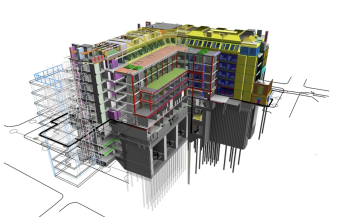
Blog / BIM & Construction Management
7 BIM sins (and how to rectify them)
Categories

In the ever-evolving landscape of construction and design, the adoption of Building Information Modeling (BIM) has become paramount for industry professionals seeking efficiency, accuracy, and collaboration.
However, as powerful as BIM is, its implementation is not without its challenges. From information overload to coordination catastrophes, the journey through the digital realm of BIM often encounters stumbling blocks that can hinder the full realisation of its potential.
In this article we explore the depths of BIM implementation, uncovering the seven sins that may be lurking in the shadows of your projects.
Sin 1: Information Overload
What is it? In the dynamic realm of BIM projects, mismanaging information can be a detrimental sin with far-reaching repercussions. Information overload, characterised by an excessive influx of project data, hampers decision-making processes and threatens project success. When overwhelmed with data, teams may struggle to discern critical details, leading to delays, miscommunications, and potential errors.
How to rectify it? Information management plays a pivotal role in streamlining data for effective decision-making. It provides the tools and strategies to organise and manage vast amounts of information and becomes a beacon in the storm of information overload. It instils the importance of structured data, teaching practitioners to categorise and prioritise information to avoid chaos.
On the other hand, structured data is the key to unlocking the true potential of BIM. When information is organised systematically, stakeholders can extract valuable insights efficiently, facilitating collaboration and ensuring that decision-makers are equipped with the right data at the right time. The sin of information overload becomes an opportunity for growth and efficiency through a structured approach.
Sin 2: Collaboration Chaos
What is it? When collaboration falters, inconsistencies in communication and a lack of standardised processes can disrupt the collaborative flow, leading to project delays and diminished overall quality. The sin of collaboration chaos can manifest as team members find themselves working in silos, unaware of each other's progress, resulting in redundancy and inefficiencies. The promise of BIM to unite professionals across disciplines becomes compromised without a structured collaboration strategy.
How to rectify it? Training in Open BIM and collaboration practices is the way. By delving into the principles of Open BIM, professionals learn how to break down silos and establish standardised processes for collaboration. It helps to bridge communication gaps, improves coordination, and leads to collaborative triumphs in the diverse and complex world of BIM projects. This also paves the way for a collaborative future where BIM thrives as a truly unified, multidisciplinary tool.
Sin 3: Coordination Catastrophe
What is it? This sin occurs when design coordination fails to achieve harmony. The consequences are significant, with clashes between elements and inadequate detection processes leading to costly on-site corrections and rework. Beyond the financial implications, the coordination catastrophe endangers project timelines and erodes trust in BIM as a reliable coordination tool. Unaddressed coordination challenges can create a domino effect, impacting subsequent project phases and jeopardising the overall success of the endeavour.
How to rectify it? By understanding the way good coordination operates. This means addressing the intricacies of coordination and understanding how to navigate the challenges of design integration seamlessly. This includes both theoretical insights, gaining a deep understanding of effective coordination strategies, and adopting the skills needed to resolve issues efficiently. We are talking about clash-free collaboration (identifying and addressing clashes early in the design phase, minimising the need for on-site corrections); interdisciplinary Integration (different disciplines, from architecture to engineering, working in harmony, sharing information and collaborating effectively); real-time communication (teams communicating seamlessly, with real-time updates and shared information, preventing misunderstandings and delays); transparent data flow (information flowing transparently across phases, ensuring consistency and accuracy from design to construction), and efficient change management, among other things.
Sin 4: Software Silos
What is it? This sin emerges when design authoring becomes confined to a single BIM software platform. This limitation poses significant drawbacks to the collaborative and integrative nature of BIM projects. When teams exclusively use one software, communication barriers arise, hindering seamless data exchange and collaboration among stakeholders. The rigid nature of software silos may lead to data loss, miscommunication, and a lack of interoperability, impeding the efficient flow of information across the project lifecycle.
How to rectify it? By advocating for a diversified skill set in BIM software. By exploring the functionalities of both Revit and Archicad, for example, professionals gain a nuanced understanding of different BIM platforms, enabling them to transcend software limitations. This gives them not just technical proficiency but also instils a mindset that encourages flexibility and adaptability in the ever-evolving landscape of BIM technology.
Professionals equipped with the ability to navigate multiple platforms become valuable assets to collaborative projects. Embracing a variety of BIM tools allows for seamless communication, improved interoperability, and a more versatile approach to project requirements. By breaking free from the constraints of software silos, practitioners can contribute to a collaborative BIM environment where the emphasis is not on the limitations of a single tool but on the collective power of a diversified skill set.
Sin 5: Analysis Paralysis
What is it? This sin unfolds when the integration of analysis tools becomes a source of challenges rather than a solution. In the complex landscape of BIM projects, the overabundance of analysis possibilities can lead to a state of indecision, where teams become hesitant to move forward. The lack of seamless integration between analysis tools and the BIM environment can result in a bottleneck, hindering progress and compromising the potential for informed decision-making.
How to rectify it? Interoperability strategies serve as a crucial compass guiding BIM professionals through the challenge of Analysis Paralysis. By adopting these strategies, professionals gain the ability to seamlessly integrate diverse analysis tools into the BIM environment, ensuring a cohesive workflow that enhances decision-making rather than obstructing it. Interoperability not only breaks down the barriers between different analysis tools but also facilitates smooth communication and data exchange across the entire BIM ecosystem. This approach empowers professionals to navigate the vast array of analysis possibilities with efficiency and confidence, preventing the stagnation often associated with Analysis Paralysis. Through interoperability, BIM professionals can make informed decisions that drive project success without succumbing to the pitfalls of indecision and delay.
Sin 6: Construction Confusion
What is it? This problem unfolds when the construction phase is marred by chaos due to inadequate BIM utilisation. In the intricate tapestry of construction projects, without proper integration of Building Information Modelling (BIM), teams may find themselves grappling with confusion, delays, and inefficiencies.
How to rectify it? Professionals must ensure comprehensive integration of BIM throughout the project lifecycle, starting from the pre-construction phase to handover. Also, coordination and site management is another indispensable tool, deploying skills to manage on-site activities efficiently, ensuring that the construction process aligns seamlessly with the digital model. Coordination becomes paramount to avoid clashes and conflicts during construction, preventing delays and inefficiencies. On the other hand, advocating a proper working culture is also paramount. This involves fostering a collaborative environment where all stakeholders, from designers to contractors, recognise the significance of BIM in streamlining construction processes.
Sin 7: Information Isolation
What is it? This problem unfolds as a significant challenge in asset management, where isolated information hampers the efficiency of the entire lifecycle. In the intricate landscape of managing assets, the lack of integration between design and asset phases can lead to disjointed data, hindering effective decision-making, and compromising the long-term viability of the built environment.
How to rectify it? Information Exchange in Asset Management emerges as a pivotal solution, offering insights into bridging the gap between design and asset phases. This requires the use of adequate tools to foster seamless information flow, ensuring that data generated during the design and construction phases remains accessible, relevant, and valuable throughout the asset's life cycle. Advocating for the importance of this seamless information exchange becomes paramount, emphasising that breaking down the barriers of Information Isolation not only enhances asset management but also contributes to a more sustainable and resilient built environment.
Mastering BIM: Your Solution to the Seven Critical Sins
Mastering the intricacies of Building Information Modeling is crucial for steering clear of these pitfalls.
For those seeking a comprehensive understanding and skill set to navigate the challenges of BIM seamlessly, consider the path of a Master's in Global BIM Management. This advanced program not only equips you with the theoretical foundations but also provides practical insights and hands-on experience to tackle the intricacies of BIM implementation.
In a world where the construction industry is becoming increasingly digitised, this program becomes a beacon, guiding professionals toward a future where BIM is not just a tool but a strategic advantage.

Related module


